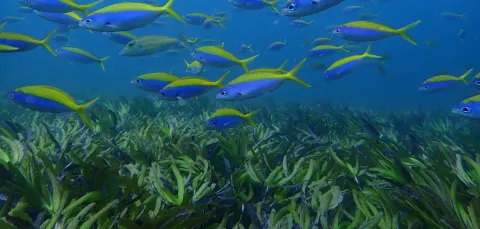Southampton researchers have discovered a way of using optical fibres to turn water into hydrogen fuel.
The team of chemistry, physics and engineering experts coated the inside of microstructured optical fibre canes (MOFCs) with a photocatalyst. This uses light from the sun to turn water into hydrogen.
The researchers' proof of concept presents a potential solution for renewable energy, the elimination of greenhouse gases and sustainable chemical production. The paper was published in the journal of the American Chemical Society.
The team is now establishing wider studies to demonstrate the scalability of the platform.
The MOFCs have been developed as high-pressure microfluidic reactors by each housing multiple capillaries that pass a chemical reaction along the length of the cane.
As well as hydrogen generation from water, the research team is investigating photochemical conversion of carbon dioxide into synthetic fuel.
Chemical engineering for green technology
Dr Matthew Potter, Chemistry Research Fellow and lead author, says: “Being able to combine light-activated chemical processes with the excellent light propagation properties of optical fibres has huge potential.
"In this work our unique photoreactor shows significant improvements in activity compared to existing systems. This as an ideal example of chemical engineering for a 21st century green technology.”
Advances in optical fibre technology have played a major role in telecommunications, data storage and networking potential in recent years.
This latest research involves experts from Southampton’s Optoelectronics Research Centre (ORC), part of the Zepler Institute for Photonics and Nanoelectronics, to tap into the fibres’ unprecedented control of light propagation.
The scientists coated the fibres with titanium oxide, decorated with palladium nanoparticles. This approach allows the coated canes to serve as both host and catalyst for the continuous indirect water splitting, with methanol as a sacrificial reagent.
Extraordinary manufacturing capability
Study co-author Dr Pier Sazio, of the Zepler Institute, says: “Optical fibres form the physical layer of the remarkable 4 billion km global telecommunications network, currently expanding at a rate of more than 14,000 feet per second.
“For this project, we repurposed this extraordinary manufacturing capability using facilities here at the ORC. We fabricated highly scalable microreactors made from pure silica glass with ideal optical transparency properties for solar photocatalysis.”
Professor Robert Raja, study co-author and Professor of Materials Chemistry and Catalysis, adds: “Over the past 15 years, we have pioneered the development of a predictive platform for the design of multifunctional nanocatalysts.
“We're excited this partnership with the ORC will lead to multiscale developments in photonics and catalysis.”





